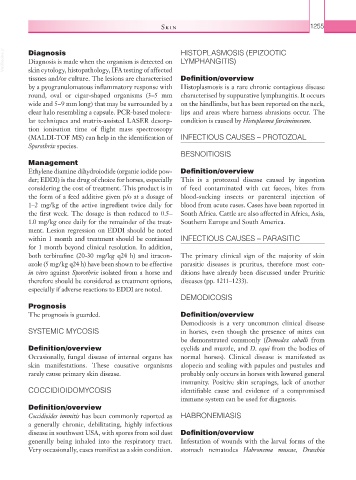Page 1280 - Equine Clinical Medicine, Surgery and Reproduction, 2nd Edition
P. 1280
Skin 1255
VetBooks.ir Diagnosis HISTOPLASMOSIS (EPIZOOTIC
Diagnosis is made when the organism is detected on LYMPHANGITIS)
skin cytology, histopathology, IFA testing of affected
tissues and/or culture. The lesions are characterised Definition/overview
by a pyogranulomatous inflammatory response with Histoplasmosis is a rare chronic contagious disease
round, oval or cigar-shaped organisms (3–5 mm characterised by suppurative lymphangitis. It occurs
wide and 5–9 mm long) that may be surrounded by a on the hindlimbs, but has been reported on the neck,
clear halo resembling a capsule. PCR-based molecu- lips and areas where harness abrasions occur. The
lar techniques and matrix-assisted LASER desorp- condition is caused by Histoplasma farciminosum.
tion ionisation time of flight mass spectroscopy
(MALDI-TOF MS) can help in the identification of INFECTIOUS CAUSES – PROTOZOAL
Sporothrix species.
BESNOITIOSIS
Management
Ethylene diamine dihydroiodide (organic iodide pow- Definition/overview
der; EDDI) is the drug of choice for horses, especially This is a protozoal disease caused by ingestion
considering the cost of treatment. This product is in of feed contaminated with cat faeces, bites from
the form of a feed additive given p/o at a dosage of blood-sucking insects or parenteral injection of
1–2 mg/kg of the active ingredient twice daily for blood from acute cases. Cases have been reported in
the first week. The dosage is then reduced to 0.5– South Africa. Cattle are also affected in Africa, Asia,
1.0 mg/kg once daily for the remainder of the treat- Southern Europe and South America.
ment. Lesion regression on EDDI should be noted
within 1 month and treatment should be continued INFECTIOUS CAUSES – PARASITIC
for 1 month beyond clinical resolution. In addition,
both terbinafine (20-30 mg/kg q24 h) and itracon- The primary clinical sign of the majority of skin
azole (5 mg/kg q24 h) have been shown to be effective parasitic diseases is pruritus, therefore most con-
in vitro against Sporothrix isolated from a horse and ditions have already been discussed under Pruritic
therefore should be considered as treatment options, diseases (pp. 1211–1233).
especially if adverse reactions to EDDI are noted.
DEMODICOSIS
Prognosis
The prognosis is guarded. Definition/overview
Demodicosis is a very uncommon clinical disease
SYSTEMIC MYCOSIS in horses, even though the presence of mites can
be demonstrated commonly (Demodex caballi from
Definition/overview eyelids and muzzle, and D. equi from the bodies of
Occasionally, fungal disease of internal organs has normal horses). Clinical disease is manifested as
skin manifestations. These causative organisms alopecia and scaling with papules and pustules and
rarely cause primary skin disease. probably only occurs in horses with lowered general
immunity. Positive skin scrapings, lack of another
COCCIDIOIDOMYCOSIS identifiable cause and evidence of a compromised
immune system can be used for diagnosis.
Definition/overview
Coccidioides immitis has been commonly reported as HABRONEMIASIS
a generally chronic, debilitating, highly infectious
disease in southwest USA, with spores from soil dust Definition/overview
generally being inhaled into the respiratory tract. Infestation of wounds with the larval forms of the
Very occasionally, cases manifest as a skin condition. stomach nematodes Habronema muscae, Draschia

